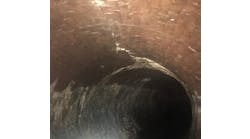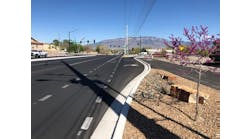From 1990, total population growth of the Phoenix metropolitan area has been the highest of any metro area in the U.S. By 2030, the Maricopa Association of Governments (MAG) projects population within Maricopa County will increase by about 70% to 6.1 million.
The largest population and employment percentage gains in this area are projected to be in the west. Growth of this magnitude and rate presents urban planners and designers with myriad challenges. Striking a balance between fiscally and environmentally responsible construction of infrastructure is certainly not the least of these challenges.
Impacts of traffic congestion and commute times in the West Valley of Maricopa County have been of major concern for some time. Solutions to these issues will remain challenging, as MAG and individual municipality officials investigate mass-transit alternatives. Park-and-ride facilities in other parts of the metro area have proven to be a popular alternative, giving rise to their promise as a vital component of the valley’s mass transit future. The city of Glendale, Ariz., has delved into the concept and will soon complete the first park-and-ride in the West Valley.
Park-and-ride facilities are free parking lots where commuters pay to catch an express, rapid-transit or local bus to their workplace or other destination. The objective of park-and-rides is to encourage public use of mass transit, decreasing the number of single passenger vehicles on the roadways. Glendale’s facility is located just northwest of the University of Phoenix Stadium, site of this year’s Super Bowl and home of the NFL’s Arizona Cardinals. The location should attract a wide range of West Valley commuters. It will feature 392 parking spaces with the potential for an additional 254 spaces in the next phase, depending on demand. If phase two is completed, it would make Glendale’s facility the largest in the state.
First flush response
A primary design concept that the city of Glendale, architect DWL Architects, civil engineer consultant Jacobs Edwards and Kelcey and sub-consultant J2 Engineering agreed upon was the optimization of environmentally sensitive materials that, among other objectives, would minimize urban heat island (UHI) effects. Upon contacting Arizona Cement Association (ACA) engineers, the design team discovered a unique pavement material that would not only address UHI concerns, but also most effectively address storm-water management, durability, structural and life-cycle cost issues. Enter pervious concrete pavement.
Pervious concrete is a discontinuous mix of uniform-graded coarse aggregate, portland cement, water and optional chemical admixtures. This mixture when properly proportioned provides an open surface texture and interconnected voids, or “channels,” within pavement, which allow storm water to pass through and directly infiltrate into permeable subgrade soils. The voids are created by eliminating the sand or fine aggregates from the mix. Typical pervious concrete has a void content ranging from 15% to 30%, allowing 200 to 400 in. per hour to infiltrate, usually preventing runoff. This far exceeds maximum storm events used by designers. Soil permeability is usually the governing design factor. Additionally, studies have shown that pervious concrete, recognized by the U.S. EPA as a best-management practice for storm-water runoff, effectively filters and treats many of the contaminants contained in the “first flush” portion of rain events, contaminants such as hydrocarbons from asphalt and car leaks. The EPA states that 90% of pollutants are typically carried by the first 1.5 in. of rainfall through traditional horizontal runoff into rivers and streams. Arid cities like Phoenix cannot afford to continue wasting this precious resource.
Soil properties for the project, determined by geotechnical consultant RAM, indicated the presence of enough clay to cause concern with allowing complete infiltration of storm water into the soil. In this case, a 6-in. drainage layer of 1-in. aggregate beneath the pervious concrete was used in conjunction with a subdrainage system and a reduced-size retention pond to store excess storm water, limiting flow through the subgrade. A woven geotextile separator fabric also was used between the subgrade and 1-in. rock layer to prevent potential migration of subgrade soil into the drainage layer and further limit storm-water infiltration into the soil. Standard pervious concrete parking lot projects with soils having a minimum percolation rate of ½ in. per hour typically eliminate the need for costly, land-wasting storm-water treatment systems, such as retention ponds, storage tanks, treatment systems and their associated drainage structures. This scenario usually results in pervious concrete yielding the lowest first cost of all pavement alternatives, without considering its many environmental advantages.
Although the Glendale park-and-ride included the subdrainage system and retention pond, a 20-year life-cycle cost analysis requested by the city and performed by Jacobs Edwards and Kelcey still showed pervious concrete pavement to be comparable to a standard asphalt pavement. Patching, seal-coating and other maintenance costs not needed by either conventional or pervious concrete were considered in the analysis and compared with periodic sweeping and joint maintenance of the pervious concrete.
The environmental advantages of pervious concrete took on even greater importance to the design team. Retention and recharge of precious ground water, use of local materials and transportation needed for pervious concrete, lack of detrimental hydrocarbons in its mix, its ability to filter runoff contaminants and its mitigation of UHI effects significantly contributed to the city of Glendale’s choice to use pervious concrete. Mitigation of UHI effects, however, was important to Glendale from the start.
In large urban areas, pavement is the largest part of the developed urban fabric. During the day, parking lots, streets and highways absorb and retain the sun’s heat. This effect is heightened by dark-colored paving and roofing materials such as asphalt and other bituminous products. The resulting UHI effect increases outdoor discomfort and creates a less sustainable urban environment, contributing to increased health problems, electricity demands, water consumption and evaporation. Temperatures in the Phoenix area are up to 15° warmer than the surrounding desert region, due in part to the UHI phenomenon.
Engineers from Arizona State University’s National Center of Excellence for Sustainable Materials and Renewable Technologies (NCE for SMART) group were asked to become involved in the project due to their continuing research and experience with “cool pavements.” ASU’s NCE SMART group had done significant research on UHI effects from pavement alternatives, including a project utilizing pervious concrete pavement for the parking lot of the Fine Arts Center on the ASU main campus in Tempe, Ariz. The open structure and lighter color of pervious concrete was shown to allow it to “breathe,” allowing passage of both water and air, and reflect much of the sun’s radiation. These properties also allow trees and vegetation better access to vital oxygen, water and nutrients, again lowering the UHI effect.
Progressive thinking
General contractor Banicki Construction chose Progressive Contracting as their pervious-concrete installation subcontractor. Progressive Contracting was the first Arizona company to become an approved installer through the National Ready Mixed Concrete Association’s (NRMCA) technician certification testing. The ACA administers the Arizona certification course and co-sponsors it with the U.S. Green Building Council’s Arizona chapter.
The pervious concrete pavement installation was scheduled during the warmest time of the year, so all placement was done at night, usually beginning at midnight or 1 a.m. Another challenge was forming and placing around the many pylons already in place for future support of steel and fiberglass covered-parking canopies. With the combination of nighttime temperatures in the 90s and “zero slump,” a very dry pervious concrete mix, quick, accurate placement, screeding, jointing and covering of the material was critical to the project’s success.
Too rapid curing of pervious concrete usually causes some loss of material at the surface level of the pavement (raveling), but Progressive avoided this issue by careful attention to the fundamental placement techniques learned through the NRMCA course and their first few projects.
After the material was properly placed and screeded with a pneumatic rolling, or “Bunyan,” screed, it was cross-rolled, jointed and covered with plastic sheeting within 20 minutes and not uncovered for a minimum of seven days. The sheeting was carefully secured, limiting the amount of evaporation from and air exposure to the pervious concrete.
At 14 days, the 6-in. pavement was subjected to loaders carrying steel members for the canopies, causing additional concern with raveling. After completion of the canopy erection, raveling was insignificant, exceeding expectations. To date, the installation appears to be of superior quality, one that should provide many years of low-maintenance operation.
Potential and promise
As population growth and resulting traffic congestion continues in the Phoenix area, cost-effective, environmentally responsible construction of facilities like the Glendale park-and-ride will continue to be pursued. Pervious concrete pavement’s ability to mitigate UHI effects, capture and filter storm water, recharge groundwater, combined with its locally produced, transported and groundwater-safe materials, make it an essential, rapidly growing part of this solution.


